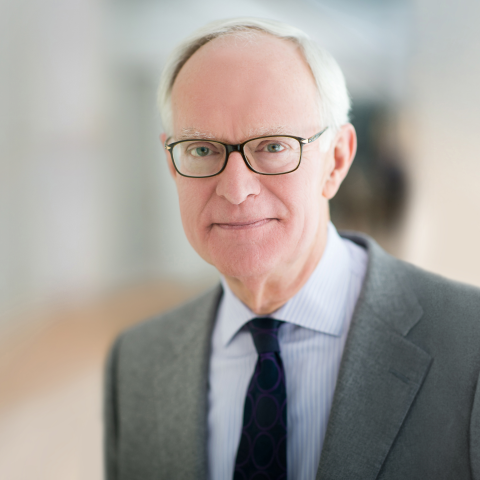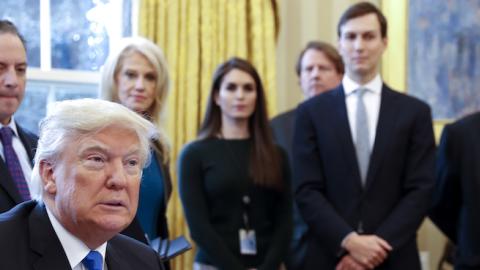Say this for Donald Trump: He does not shrink from controversy. As the president’s cabinet nominees came under Senate questioning, several expressed clear disagreements with their new boss. Defense Secretary Jim Mattis presented Russia as a threat; Secretary of State Rex Tillerson urged action on climate change; budget nominee Mick Mulvaney stood firm for entitlement reform.
Pundits have used these differences to portray a new administration born in disarray. Yet perhaps we are witnessing something else. Such frankness from cabinet nominees is a refreshing departure from the customary spectacle of officials robotically repeating their talking points. President Trump has not only picked extraordinarily capable men and women, he has self-assuredly encouraged them to speak their minds. “I want them to be themselves,” he tweeted, “and express their own thoughts, not mine!”
President Trump may be rediscovering a venerable method of leadership that has been forgotten in our era of ideological messaging. Rather than viewing disagreement as a problem, previous American leaders wielded it as a tool. They surrounded themselves with highly accomplished, strong-minded advisers, and used vigorous debate among them to generate fully considered options for confronting the intractable problems of the day.
The method was invented by George Washington, as the historian David Hackett Fischer explains in his book “Washington’s Crossing.” As a young man Washington had observed the hierarchal, autocratic leadership of the British military in the French and Indian War. But he realized early in the Revolutionary War that those methods were unsuited to his task. The American forces were fractious, culturally diverse amateurs, and the war required constant extemporizing.
This led Gen. Washington to devise a new form of war council. Instead of handing down battlefield assignments, it was devoted to hearing out impassioned arguments over strategy and tactics among officers of distinct backgrounds and inclinations. Washington listened and asked probing questions. When he made his eventual decision, everyone understood why, and knew that it took full account of the risks and uncertainties that their deliberations had revealed.
Prof. Fischer extended his analysis to the presidencies of Washington, Abraham Lincoln and Franklin D. Roosevelt in a 2006 lecture at the American Enterprise Institute (available at C-Span.org). Washington’s first term had him once again navigating uncharted territory with everything at stake. Vice President John Adams, Secretary of State Thomas Jefferson, Treasury Secretary Alexander Hamilton, and congressional ally James Madison were among the greatest men of the age. They represented key constituents of American society, politics and philosophy. Washington made creative use of the conflicts among them, notably in the debates over whether the federal government should assume state war debts and establish a national bank—as celebrated in Lin-Manuel Miranda’s musical “Hamilton.” Washington’s studied aloofness permitted opinion to mature in Congress and the states, allowed new coalitions to form, and led to serviceable compromises on what had been impossibly divisive problems.
Lincoln and FDR adopted similar methods in similarly grave and momentous times. Lincoln’s cabinet included eminent political opponents—the aggressively conniving “team of rivals” of Doris Kearns Goodwin’s study—whom the president encouraged to disagree while he listened intently. FDR fomented competition within highly diverse cabinets and academic “kitchen cabinets” that included prominent Republicans such as Henry Stimson.
Both presidents eschewed ideology for simple, overarching principles—for Lincoln, human equality and preservation of the union; for Roosevelt, fairness and freedom from fear and want. This preserved tactical flexibility. Lincoln’s motto was “my policy is to have no policy,” while FDR shifted unpredictably from left to right and back again. Both were secretive and manipulative, and kept friends and foes guessing until the moment to act was nigh—sometimes at their own instance (the Emancipation), sometimes at the instance of others (Pearl Harbor and Hitler’s declaration of war).
The methods of Washington, Lincoln and FDR have sometimes been adopted by their successors. Richard Nixon, in his early years, orchestrated intense, often fruitful debates over foreign, domestic and fiscal policy among the brilliant professoriate he had assembled: Henry Kissinger ,Daniel Patrick Moynihan, Arthur Burns,George Shultz, Paul McCracken and Herbert Stein.
Ronald Reagan, at once a libertarian conservative and political pragmatist, was thoroughly comfortable with the clash of ideas. Early in his first term, he was confronted by a reporter with purportedly scandalous rumors: Secretary of State Alexander Haig and Secretary of Defense Caspar Weinberger had been arguing openly in front of him. Reagan’s answer: Of course—that’s their job! His penchant for ending contentious meetings with a well-rehearsed joke or Hollywood story, to the frequent exasperation of his interlocutors, was his way of standing back and letting the disagreement continue for a time.
Reagan was particularly adept at maintaining independent channels of information and counsel, so as not to become captive to government groupthink. The classic ending for a White House decision memo is to present three options: 1) Abject Capitulation; 2) Nuclear Annihilation; 3) the Staff Recommendation. Not infrequently, Reagan would choose Option 7, an utterly different approach concocted on the side with advice from California business magnates or from Milton Friedman or Edward Teller at the Hoover Institution. The news reports that Reagan was “out of touch” often meant that his staff had griped he was out of touch with their preferences.
At the other end of the spectrum, the least successful modern presidents were the insular Jimmy Carter, who disdained disagreement, and the rigid ideologue Barack Obama, who, in George Will’s formulation, “never learned anything from anyone with whom he disagreed.” In contrast, Bill Clinton enjoyed mixing it up with conservatives, who were often impressed that the president knew their arguments as thoroughly as they did.
The two Bushes were intermediate cases, both a bit too attached to tidy lines of authority. When George H.W. Bush called off military operations against Iraqi forces in 1991, immediately after liberating Kuwait, he was being shielded from strong disagreement within his administration among those who believed Saddam Hussein’s invasion was a strong casus belli for removing him from power. The mistake became horribly clear as soon as the president urged Iraqis to overthrow the dictator on their own: Within weeks, Hussein’s troops slaughtered tens of thousands of civilians, displaced millions, and committed unspeakable atrocities.
In contrast, George W. Bush’s 2007 Iraq “surge” was developed entirely outside his administration and strenuously opposed within it. The outsourcing of military policy, highly atypical of President Bush and deep into his second term, turned imminent defeat into a victory that advanced for the remainder of his administration.
Now President Trump’s leadership style is unorthodox and often unsettling. His methods, derived from business and popular entertainment rather than politics, are in many respects unlike anything that has come before. Yet they are not entirely unprecedented.
He forgoes ideology for simple, cross-partisan principles: America First, safety from terrorism and violent crime, better jobs and schools for the poor and working class, defiance of self-serving elites. He has filled his cabinet with people of proven talent, including erstwhile opponents Ben Carson and Rick Perry, and named a diversified team of White House advisers. Mr. Trump cultivates independent sources of information and is unlikely ever to become captive to his staff. He is unpredictable and uses his talent for drama to keep allies focused and opponents distracted.
Most of all, President Trump is comfortable with controversy and dissent, indeed often incites them to advantage. His tweets and pronouncements can be outrageous and overstated—Up to a point, Lord Copper!—but they demonstrate a healthy skepticism toward ossified orthodoxy and, critically, are designed to stimulate debate rather than close it down.
For instance, global warming is not a “hoax,” as Mr. Trump has said. But the public and scientific debates over climate change have involved several hoaxes, one of which is the deliberate conflation of causation, degree, consequence and policy response. Several of the president’s officials are now propounding the more nuanced view and disentangling the critical distinctions. Deliberation on an important, complicated problem is opening up.
The result may be similar with the fracas over Russian email hacking during the election campaign. Mr. Trump’s attacks on the official intelligence report, and his mischievous nod to WikiLeaks, helped show how overcentralized and fragile America’s intelligence establishment has become. It is indeed “politicized,” in the sense of being organized, at the top, by consensus-seeking committees. It employs bureaucratic verbiage to mask conflicts of fact and interpretation. It is increasingly vulnerable to unfiltered information from the outside, leaked or otherwise. We shall see what President Trump does with a system that asks him to make decisions based on distinctions between “probable” and “highly probable” intelligence estimates, while Stephen Bannon scours the internet for second opinions and counterfactuals.
Mr. Trump’s zest for debate and willingness to defer to subordinates (as he did to Mr. Mattis on the question of rough military interrogations) make him more transparent than his predecessors. He is not sphinxlike but garrulous and opinionated, not a raconteur but always smack in the argument. So far, he has been adept at indicating when the time for talk is over, as when he shut down the Republican debates over ObamaCare “repeal and delay” and the House’s overhaul of its ethics office. That suggests he will be decisive in informing subordinates when the moment has arrived to stand together. Time will tell, though, how he adjusts to reversals and instances of “mistakes were made,” such as the sloppy immigration executive order, which was a mistake, precisely, of inadequate internal ventilation.
The focus, for now, should be on the quality and diversity of views that inform President Trump’s decisions. For instance, his intelligence reforms are off to a good start but will encounter fierce bureaucratic resistance. Success will require pertinacious leadership from the White House. A key indicator will be whether the hard, granular conflicts, coming from agencies with radically different methods and assumptions, make it into the Oval Office without being homogenized by the director of national intelligence.
A complementary step would be an official, proactive WikiLeaks initiative. As Mary Graham shows in her forthcoming book “Presidents’ Secrets,” government classification is used routinely to conceal blunders, protect careers and buttress agency prerogatives. Over the years, many official declassification projects have come to naught. Nota bene, Mr. Trump: the president can declassify documents himself.
Mr. Trump should also bring a top economist or two into the White House, to balance and challenge the views of the financiers, business executives and political activists he has already assembled. Economics cannot do all the things practical men would like it to, but it is a highly developed discipline with many useful insights. Such as: A tax on imports is a tax on exports. And: Markets compensate for policy changes, always reducing and sometimes repealing the effects that had been hoped for. Moreover, the consequences of President Trump’s bold tax, trade and regulatory initiatives will eventually be measurable. That will lead to a new round of debates, more empirical than the ones we are having today. Economists will be better equipped than anyone to analyze and interpret the data for the president and for the rest of us.
Competition of ideas is a strength of democracy, not a weakness, not only in politics but in government itself. Although President Trump has his differences (of course!) with Lin-Manuel Miranda, he should take heart from the percussive arguments between Hamilton and Jefferson and the tradition of creative disputation that President Washington inaugurated.















